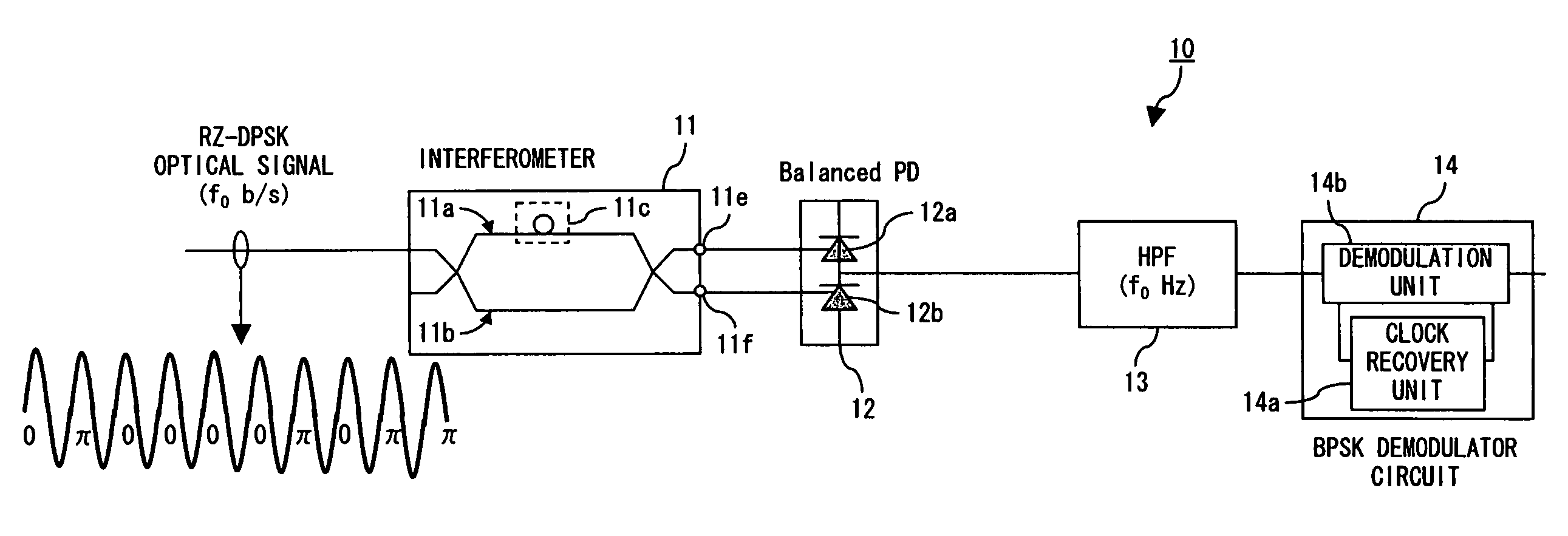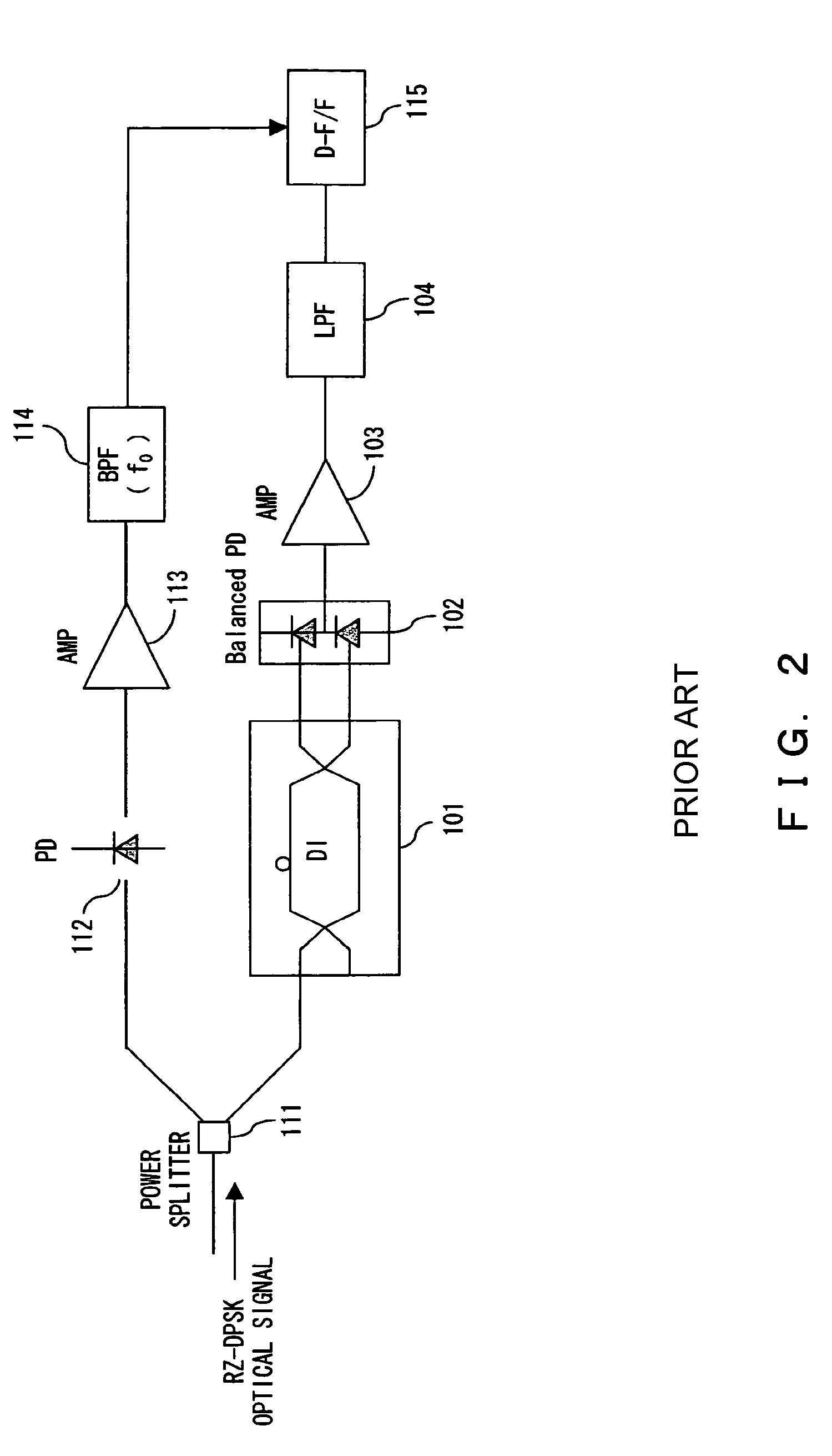RZ-DPSK optical receiver circuit
a receiver circuit and optical receiver technology, applied in the field of optical receiver circuits, can solve the problems of deterioration of optical s/n ratio in the receiver apparatus, cdr circuit, and difficulty in recovering high-speed data faster than 20 gbps, and achieve the effect of improving receiver sensitivity and simple and low-cost configuration
- Summary
- Abstract
- Description
- Claims
- Application Information
AI Technical Summary
Benefits of technology
Problems solved by technology
Method used
Image
Examples
first embodiment
[0064]FIG. 11 is a diagram showing a configuration of an optical receiver circuit of the first embodiment. The interferometer 11, the balanced photodiode 12, the high-pass filter 13 and the BPSK demodulator circuit 14 can be the same as the above.
[0065]An amplifier 31 is provided between the balanced photodiode 12 and the high-pass filter 13, and amplifies the differential reception signal acquired by the balanced photodiode 12. By providing the amplifier 31, the receiver sensitivity is improved.
[0066]A low-pass filter 32 filters the differential reception signal amplified by the amplifier 31. The cut-off frequency of the low-pass filter 32 is about 70 percent of the data rate (f0) of the transmission data, for example. By providing the low-pass filter 32, the noise is removed and the waveform is improved.
[0067]A determination circuit 33 is a D flip-flop, for example, and determines the logical value of the output signal of the low-pass filter 32 at rising edge timing of a clock sig...
second embodiment
[0069]FIG. 12 is a diagram describing a configuration of an optical receiver circuit of the second embodiment. The interferometer 11, the balanced photodiode 12, the high-pass filter 13, the BPSK demodulator circuit 14, the amplifier 31, the low-pass filter 32 and the determination circuit 33 can be the same as explained above.
[0070]A variable delaying circuit 41 delays a clock signal provided from the BPSK demodulator circuit 14 to the determination circuit 33. The delay created by the variable delaying circuit 41 is adjusted by a control signal generated by a control circuit 43. An exclusive OR circuit 42 performs exclusive OR operation of data stream output from the BPSK demodulator circuit 14 and data stream output from the determination circuit 33. The control circuit 43 generates a control signal for adjusting the delay of the variable delaying circuit 41 based on the exclusive OR data.
[0071]In the optical receiver with the above configuration, when the phase of a clock signal...
third embodiment
[0073]FIG. 14 is a diagram showing a configuration of an optical receiver circuit of the third embodiment. The interferometer 11, the balanced photodiode 12, the high-pass filter 13, the BPSK demodulator circuit 14, the amplifier 31, the low-pass filter 32, the determination circuit 33, and the exclusive OR circuit 42 can be the same as explained above.
[0074]A limiter amplifier 51 amplifies the output signal of the low-pass filter 32 to a prescribed limit value, using a dynamically adjustable determination point (a threshold level). As the determination point changes, the waveform of the output signal of the limiter amplifier 51 also changes accordingly. The determination circuit 33 determines the logical value of the signal amplified by the limiter amplifier 51 using the clock signal provided from the BPSK demodulator circuit 14. A control circuit 52 controls the determination point of the limiter amplifier 51 based on the output of the exclusive OR circuit 42. At that time, when t...
PUM
 Login to View More
Login to View More Abstract
Description
Claims
Application Information
 Login to View More
Login to View More - R&D
- Intellectual Property
- Life Sciences
- Materials
- Tech Scout
- Unparalleled Data Quality
- Higher Quality Content
- 60% Fewer Hallucinations
Browse by: Latest US Patents, China's latest patents, Technical Efficacy Thesaurus, Application Domain, Technology Topic, Popular Technical Reports.
© 2025 PatSnap. All rights reserved.Legal|Privacy policy|Modern Slavery Act Transparency Statement|Sitemap|About US| Contact US: help@patsnap.com



